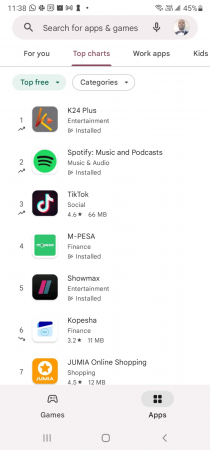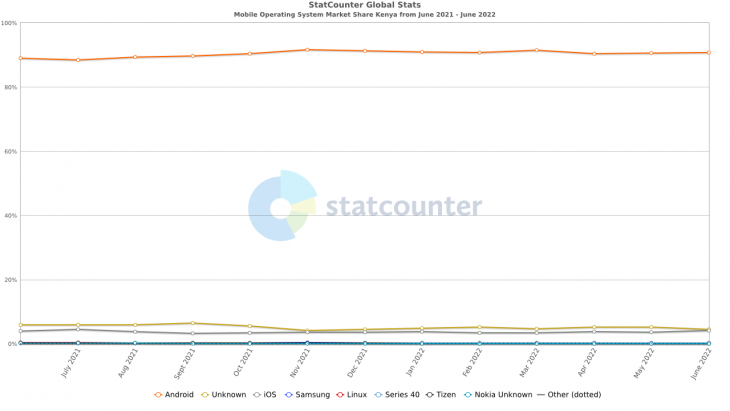Setting up your app for success: Lessons from Kenya’s best mobile app 2022, K24Plus

The Digital Media Awards, last week, picked the K24Plus app as Kenya’s best mobile app for 2022, citing its design and ease of use, its relevance to the target market and its innovativeness as some of the reasons the app won.
You don’t have to take the DMA’s word for it–in the seven or so months since we officially launched in December 2021, we’ve also consistently ranked among the top free apps in Kenya on Google Play, no mean feat considering the competition we have in the likes of TikTok and Spotify.

It takes a big team and a lot of effort to build an app that works well and we at The Africa Growth Lab–a digital consultancy with expertise in UI/UX, Performance Marketing, publisher monetization and data–are very proud to have been part of that team and of our contribution to its success as the acquisition, strategy, monetization, UI/UX and measurement consultants for the app.
From the research and work we’ve done, together with the data we’ve gathered and analyzed, here are some lessons we’ve learnt on building and deploying a best-in-class app in Africa that we would recommend you think about for your own app.
- Do you even need an app in the first place? Do you need an iOS one in Africa?
Native Apps on Android and iOS are written to run on mobile devices, providing enhanced performance and a broader scope of features compared to mobile sites.
On the other hand, mobile sites can reach anyone, anywhere, on any device with a single codebase. They also offer transparent and straightforward deployment, linkage and measurement mechanisms and there are no delays on updates.
We recommend that developers and business owners think carefully about the functionalities they’d like to deploy, and research on modern web app technologies such as Progressive Web Apps (PWA) before making the call on developing an app.
Some of the things you can achieve with PWA that were previously only available in native apps include:
● Users can add the app icon to their home screens
● They can see and interact with your content, even when offline
● Push notifications to re-engage with your audience
Given Android’s dominance on mobile (a 90% market share compared to iOS’ 4%), we also recommend giving some thought to whether you actually need an iOS app.

- Measure what matters
You probably know how many installs of your app you’ve driven so far but are you measuring and attributing where those installs came from? Or how many of the folks who’ve installed your app come back to it daily or weekly and how many uninstalled it? Are you keeping tabs on where people drop off in the app (which could give you an indication of your users’ pain points)? What content on the app are people resonating with? How much revenue have you made from sales or subscriptions or advertising?
All these (and lots more) are questions the right measurement plan and analytics partner can help you answer. Without proper measurement, it would be impossible to accurately gauge what’s working or not with your marketing, user interface and content or to uncover insights that can inform your app strategy.
Spend some time thinking about your overall business, marketing and digital objectives and what KPIs you’ll need to measure for each, and work with a measurement specialist to deploy the right solutions
One point to remember here is that attribution for app installs and app measurement generally is fundamentally different from web measurements because there are no cookies in the app world. Rather than implementing pixels or tags like you would on the web, apps require deploying a System Development Kit (SDK).
Some of the app measurement partners you might want to consider are Firebase (free) and Appsflyer and Adjust that typically have a free tier but will charge for usage above certain limits.
- Digital media works
In the 6 or so months since we launched the app, the value of the media exposure we’ve gotten from our sister brands in the Mediamax Group has been more than 7X what we spent on digital media, yet we noticed from earlier on that more than 80% of our installs were directly attributable to digital media.
There’s definitely a lot to be said for traditional media and its value in driving awareness, believability and consideration but digital media, especially the AI-powered app install campaigns on Google and Facebook have been crucial in driving the nearly 1M downloads we’ve pushed in 6 months.
- Audiences and re-engagement
Research shows that even the best optimized checkout process will still have a cart abandonment rate upwards of 20%, with most retailers reporting rates of between 60% to 80%.
If we look specifically at apps:
- 75% of smartphone users who have downloaded an app promptly forgot it was on their phone.
- Only 37% of installs remain in use after 7 days.
Whether you are trying to gently nudge users to close the deal or you want to remind your loyal subscribers that you have a new title they might love coming out next week, you’ll need to think about how you segment your active and prospective customers and how you can re-engage with them to get them to subscribe or buy, to retain them as customers, to upsell to them or even to activate them in the first place.
Here’s an example of how we’d build an audience on Appsflyer of app users who’ve viewed our content in the past 30 days but haven’t completed registration yet.

- If speed thrills, friction kills
It’s hard to overstate the importance of having an intuitive user experience on your digital touchpoints that deliver delightful, seamless experiences to your customers.
In a 2015 Forrester Consulting study, they reported that 29% of smartphone users will immediately switch to another site or app if it doesn’t satisfy their needs (e.g. they can’t find information or it’s too slow). And how long is too long? 40% of shoppers in the same study said they will wait no more than three seconds before abandoning a retail or travel site.
So how do we try to be deliberate about presenting our users with a fast, intuitive experience?
- By asking lots of questions
Here are some you should also be asking yourself about your app or site
- What is the key action you want users to take on your site or app? How long does it take to perform it?
- Which functions on your mobile site are absolutely, positively, undeniably essential for your customer?
- What do you already know about your customer that can help you anticipate their needs?
- How long does it take for your property to load?
- Regular usability tests
We recommend working with a UX expert to schedule for regular usability tests that will help you uncover potential sources of friction like:
- Navigation errors – failure to locate functions, excessive keystrokes to complete a function, failure to follow recommended screen flow.
- Payments errors – failure to pay for content, lack of understanding on why they need to pay and how to pay
- Presentation errors – failure to locate and properly act upon desired information in screens, selection errors due to labeling ambiguities.
- Control usage problems – improper toolbar or entry field usage.
- Keep an eye on the data
Data from analytics tools like Firebase or Google Analytics can help you uncover where users are having challenges with your property. You can also run performance audits using automated tools like Lighthouse from Google.












